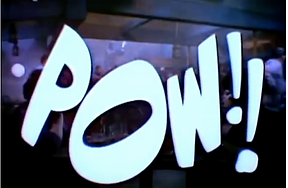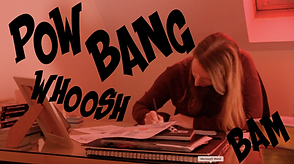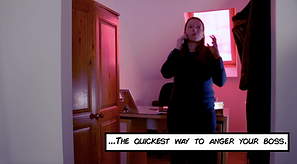
EDITOR
Keanu Reaves in Scanner Darkly

The 7 Billionth Hero
Comic world effect

Batman 1966


The 7 Billionth Hero
Text Effects

Coalition, P. (2018). ART OF THE CUT with Avengers - Infinity War editor, Jeffrey Ford, ACE by Steve Hullfish - ProVideo Coalition. [online] ProVideo Coalition. Available at: https://www.provideocoalition.com/art-of-the-cut-with-avengers-infinity-war-editor-jeffrey-ford-ace/ [Accessed 1 May 2019].
Dancyger, K. (2011). The Technique of Film and Video Editing: History, Theory and Practice. 5th ed. Taylor & Francis., pp.17-21.
As an editor Jeffery Ford said he learnt that when he's editing he's not making a movie that feels like a Jeffery Ford movie, it has to feel like the directors movie.(Coalition, 2018) Which is why I work very closely with Lauren (The Director) when editing. To make sure that I edit the scene to be everything she wants it to be. To do this I had to take her ideas and bring them to life.
Laurens ideas for The 7 Billionth Hero was a montage scene where the character of ‘Catherine’ is an investment banker who is stuck in the same routine and uses her hobby of creating graphic novels to escape this. Through the montage we see Catherine getting more and more stressed out with work and spending more time drawing. As this happens the montage slowly graduates to Catherine becoming part of this graphic novel world.
In order to achieve this, I had to edit the scenes together to create the montage but also use motion graphics and effects to create this transition into another world.
To prepare for this I researched different forms of media to see how they achieved similar effects to inspire our own work.
One effect that is really important to the end of the montage is the transformation of Catherine from her home office to the comic book world. To create this, we wanted to change the Foreground behind her as she was drawing and also by making her look cartoon like. To do this I used a mask and Keyframed it to move when Catherine does. A major influence to this effect was the movie ‘Scanner Darkly.’ The entire movie was filmed and then rotoscoped in post-production to look like an animation but also keep the actors looking like the actors. So, this is very similar to what we wanted to create we want Catherine to look like herself but to be so consumed by her drawing that she goes into that world.
There were other smaller more subtle effects that we included to gradually build upon Catherine being drawn into the comic book world. These included simple use of text graphics which additionally added to the scene story. These were influenced by the old ‘Batman’ series from 1966. This series took speech bubbles and action words that appear within the Batman comics and used them in their series. We choose to include these effects also to keep within that comic book theme and genre but also add to our story.
Other than the effects an important part of the editing process was creating the Overtonal montage that we set out to make. To do this I started with researching Montage as a theory and Sergi Eisenstein.
By doing this I learnt all about his theory of five editing compensates; Metric, Rhythmic, Tonal, Overtonal and Intellectual Montage. Our aim was to make an Overtonal montage which turns out to be the combination of Metric, rhythmic and Tonal. This combination creates an interplay of pace, ideas and emotions. Metric Montage focus on the pace of the edits by the lengths of the shots and their relativity to each other. By shorting shots, it means audiences have less time to absorb the information which leaves the audience feeling more tension. Rhythmic montage refers to the continuity of the shots and the visual patterns it creates. This allows Rhythmic montage to portray conflict between the opposing forces. Lastly Tonal montage is all about the mood and emotions of the character’s and how these change throughout the montage. This is effectively done through music. (Dancyger, 2011)
To make The 7 Billionth Hero an Overtonal montage as we control the pace to speed up and slow down to build the tension of the audience to allow them to feel how the character is feeling. So, when the character is feeling stressed, we have quick cuts with short shots. An example of this is when Catherine is meeting with clients and we use jump cuts one after the other leading up to all three building up like comic book panels on the screen to build the tension of the scene to relay to the audience the stress that Catherine is feeling. (Which can be seen in the screenshot below.) We ensure that the montage has elements of Rhythmic Montage by the use of continuity through the montage and create a conflict between Catherine and her job and also between the two worlds that are merging together. Finally, the tonal change in the middle, which we create by the change in music and the progression of the effect, creates a tonal montage. These elements all merged together create our Overtonal montage.
